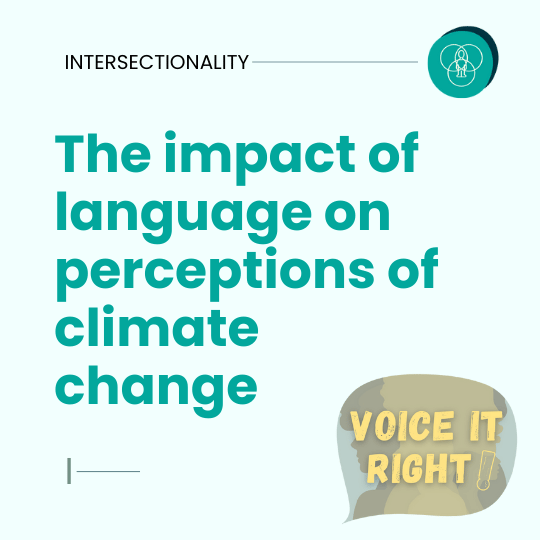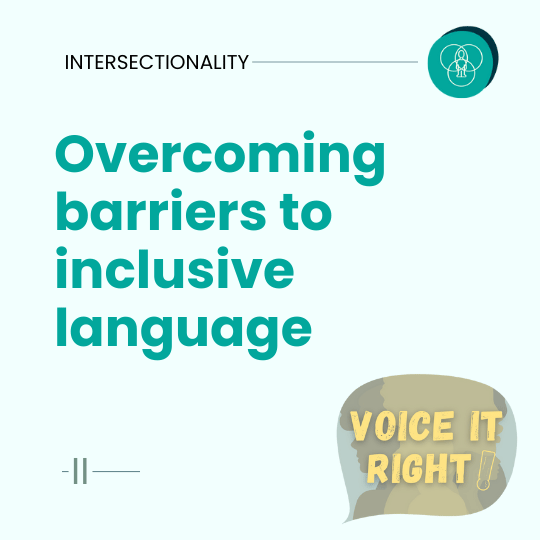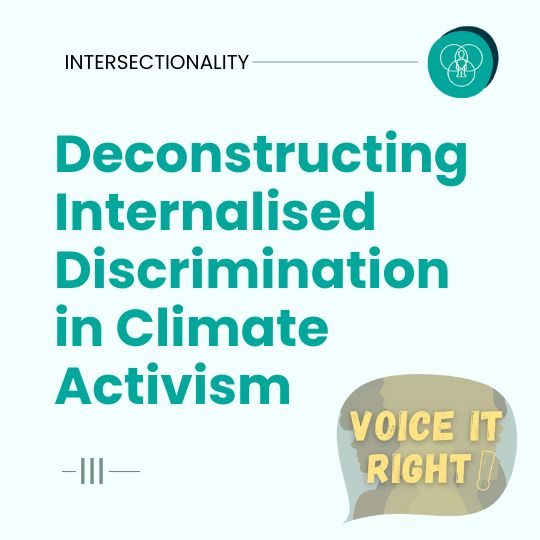
Share this article
Written by

Martina Mussa
Contents
Sources:
- Language exclusion: the unheard face of the climate crisis
- COP28 and beyond: Five tips for gender-inclusive climate reporting
- Inclusive climate action in practice 3.0: Gender
- How Can Climate Action Be Inclusive?
- daily.jstor.org
- Compass – Manual for Human Rights Education with Young People; II Edition updated in 2020.
- Inclusion Toolbox – A guide on inclusive practices; European Youth Foundation, Council of Europe.
- The environmental movement is very white. These leaders want to change that.
- Paternalistic and ‘othering’ language in the charity sector
- Overcoming Language and Cultural Barriers: Promoting Inclusion in Multilingual and Multicultural Workplaces
- From Talk to Action: Rethinking the Language of Climate Change
- Language: a tool for activism and preserving peace
- How Can Climate Action Be Inclusive?
- Manual for the design of a training course on intercultural competence
- Inclusive language guide
Follow the #VoiceItRight campaign on
As we already mentioned, in the context of youth work and climate activism, language plays a pivotal role in shaping perceptions, influencing behaviour and reflecting values. Inclusive language ensures that climate activism is accessible and welcoming to all, regardless of background or identity.
This is crucial to avoid bias, stereotypes or expressions that discriminate against groups of people based on race, gender, socioeconomic status, disability or other factors.
Inclusive (intercultural) communication: is a transparent, truthful, accessible, and engaging communication that reflects the diversity of the society, promotes a climate of openness to intercultural encounters, and creates a shared sense of belonging.
Understanding barriers to inclusive language
If we want to foster inclusive language in our work for climate action it is important to recognise obstacles and barriers that can be hinder climate activism initiatives and inadvertently marginalise groups. In fact, many environmental terms were developed in context that did not prioritise inclusivity. For instance, the term “Developing countries” can be considered paternalistic.
Lack of diversity within environmental movements and youth organisations can lead to the exclusion of voices and perspectives that could otherwise share best practices and useful approaches to foster inclusivity.
By understanding and addressing these barriers we can foster communication that is equitable, accessible and truly representative of diverse perspectives. This awareness can help us to avoid language that can unintentionally exclude, alienate, or marginalise certain groups, perpetuating existing inequalities and limiting participation. A language that is inclusive and culturally sensitive serves as a tool for empowerment, fostering dialogue, and building inclusive movements that reflect the needs and contributions of all people.
Prevalence of technical language
The extensive use of jargon and technical language can make environmental issues seem inaccessible or irrelevant to those without a background in the field. In fact, too often scientists use the deceptively passive “neutral” language to explain climate change-related events to better reflect both scientific accuracy and the true gravity of the situation.
At the same time, the media tend to follow the scientists’ lead, by adopting the so-called “neutral” language in order to avoid alarming anyone with any uncomfortable emotions.
This has serious consequences, as it may limit the reach of activism’ initiatives. In fact, only people with certain knowledge on the topic or educational levels feel qualified to participate.
Cultural and linguistic differences
Environmental activism often originates in contexts where the dominant cultural norms shape the discourse, potentially excluding those from different cultural backgrounds who may have unique perspectives on environmental issues. A core example of this is the role of indigenous communities, who are often at the forefront of environmental stewardship and yet could find their voices marginalised if the language used does not reflect their experiences.
Western-centric approaches
Too often environmentalism has been shaped by and centred on western perspectives. This western-dominated approach typically emphases certain principles, practices and solutions that may not align with the environmental realities or cultural values of non-Western communities.
An example of this approach relies on the focus on conservation efforts like national parks or wildlife reserves, which are rooted in the idea of preserving “pristine” nature. Despite the good intentions behind these methods, they might hinder or even undermine the traditional ecological knowledge of indigenous and local communities who have been sustainably managing their environments for generations.
Another consistent difference is the tendency of framing environmental issues through a lens of individual responsibility. This includes reducing personal carbon footprints or adopting a sustainable lifestyle. Although these actions are important, they often do not consider structural inequalities that disproportionately affect non-Western and vulnerable groups. In fact, most communities in the Global South who contribute the least to global carbon emissions are the most affected by and suffer the most from the consequences of climate change. However, the dominant narrative may place undue emphasis on individual actions without addressing the larger, systemic forces driving environmental degradation.
Stereotypes
A certain use of language can perpetuate stereotypes and bias or fail to acknowledge systemic inequalities. This has the potential to alienate marginalised groups. For instance, framing environmental issues solely in terms of individual responsibility can overlook the disproportionate impact of environmental degradation on low-income and vulnerable communities, who may have less capacity to effect change through personal choices alone. As a consequence, feelings of exclusion or frustration can characterize those who feel that their struggles are not being adequately addressed.
How to ensure inclusive (intercultural) communication
According to the Council of Europe guidelines, we can distinguish three key components of inclusive communication.
- Accessibility for everyone
- Representativity of the population
- Narratives that favour openness to valuing diversity.
Accessibility
Everyone has access to – and ability to understand and feel targeted by – public communication and information that is needed to fully enjoy their rights. The words and images used, the communication channels, the language style and availability of the core information in several languages, are important features for inclusive communication.
In environmental activism it is crucial to keep a simple language in order to allow the message to come across and reach a larger audience. In fact, language barriers are a problem for English speakers all over the world, not just non-native speakers. As the majority of projects are conducted in a language not native to the participants and the audience, there will inevitably be language challenges. Also, the discourse surrounding climate change is characterised by complex jargon, unclear definitions, and a constantly changing language.
Furthermore, equality has always to be taken into account: as societies are even more diverse and multicultural, it may be necessary to provide contents in different languages, by providing translations or subtitles.
When having conversations about climate change, linguistic inclusiveness shouldn’t come last. It is critical that we spread the word about how crucial it is to include linguistic diversity in climate solutions.
It is equally important to use gender-neutral language to describe a group of people in order to avoid generating a feeling of exclusion.
Representativity
In the context of climate activism, it is essential to embrace pluralism in the environmental discourse, in order to incorporate a wide range of voices, particularly those from non-western and marginalised communities.
A clear example are indigenous people, whose wisdom and customs to reduce the effects of climate change’s effects can be complementary to our competence to safeguard the planet. Furthermore, SDG17—partnership, which is at the centre of the Sustainable Development Goals—is also in jeopardy when there is a lack of inclusivity in the discourse.
Inclusive and alternative narratives
By ‘alternative narratives’ we intend pluralist, progressive, and human-rights-based communications of facts and commentaries in relation to phenomena which may be subjected to prejudice, stereotypes and hate speech. In this sense, alternative narratives are a form of constructive and inclusive communication, promoting critical thinking while avoiding a paternalistic or morally superior attitude.
In the framework of climate action, the human rights-based approach is translated into the attention to how environmental issues disproportionately impact vulnerable communities. This leads to the use of a language that advocates for the rights and well-being of marginalised groups.
By framing environmental issues within a human rights context, we can highlight the connections between environmental justice and social justice, ensuring that the movement addresses both environmental degradation and the inequalities that exacerbate it.
Adopting alternative narratives means also avoiding paternalism and morally superior tone, by encouraging people to dialogue and questioning dominant narratives. This approach fosters a more collaborative and respectful movement where all participants feel valued and heard, without making them feel like they are being talked down to or excluded.
The core point is to focus on building bridges and being mindful of how language can bring people together rather than alienate and divide them. By using inclusive and culturally sensitive language, we can avoid reinforcing existing prejudices and perpetuating stereotypes.





 YEE aims to unite environmental youth non-profit organisations in Europe in order to enhance international cooperation, increase knowledge about the climate crisis, raise awareness of environmental problems and to strengthen participation of youth in environmental decision-making.
YEE aims to unite environmental youth non-profit organisations in Europe in order to enhance international cooperation, increase knowledge about the climate crisis, raise awareness of environmental problems and to strengthen participation of youth in environmental decision-making.

